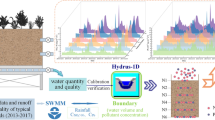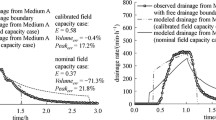Abstract
Stormwater runoff is one of the most common non-point sources of water pollution to rivers, lakes, estuaries, and coastal beaches. While most pollutants and nutrients, including nitrate-nitrogen, in stormwater are discharged into receiving waters during the first-flush period, no existing best management practices (BMPs) are specifically designed to capture and treat the first-flush portion of urban stormwater runoff. This paper presents a novel BMP device for highway and urban stormwater treatment with emphasis on numerical modeling of the new BMP, called first-flush reactor (FFR). A new model, called VART-DN model, for simulation of denitrification process in the designed first-flush reactor was developed using the variable residence time (VART) model. The VART-DN model is capable of simulating various processes and mechanisms responsible for denitrification in the FFR. Based on sensitivity analysis results of model parameters, the denitrification process is sensitive to the temperature correction factor (b), maximum nitrate-nitrogen decay rate (K max), actual varying residence time (T v), the constant decay rate of denitrifiying bacteria (v dec), temperature (T), biomass inhibition constant (K b), maximum growth rate of denitrifiying bacteria (v max), denitrifying bacteria concentration (X), longitudinal dispersion coefficient (K s), and half-saturation constant of dissolved carbon for biomass (K Car-X); a 10% increase in the model parameter values causes a change in model root mean square error (RMSE) of −28.02, −16.16, −12.35, 11.44, −9.68, 10.61, −16.30, −9.27, 6.58 and 3.89%, respectively. The VART-DN model was tested using the data from laboratory experiments conducted using highway stormwater and secondary wastewater. Model results for the denitrification process of highway stormwater showed a good agreement with observed data and the simulation error was less than 9.0%. The RMSE and the coefficient of determination for simulating denitrification process of wastewater were 0.5167 and 0.6912, respectively, demonstrating the efficacy of the VART-DN model.






Similar content being viewed by others
References
Thurston KA (1999) Lead and petroleum hydrocarbon changes in an urban wetland receiving stormwater runoff. Ecol Eng 12(3–4):387–399
Ngabe B, Bidleman TF, Scott GI (2000) Polycyclic aromatic hydrocarbons in storm runoff from urban and coastal South Carolina. Sci Total Environ 255(1–3):1–9
Deng ZQ, Lima JLMP, Singh VP (2005) Fractional kinetic model for first-flush of stormwater pollutants. J Environ Eng 131(2):232–241
Deletic AB, Maksumovic CT (1998) Evaluation of water quality factors in storm runoff from paved areas. J Environ Eng 124(9):869–879
Gupta K, Saul AJ (1996) Specific relationships for the first flush load in combined sewer flows. Water Res 30(5):1244–1252
USEPA (1995) Combined sewer overflows: guidance for nine minimum controls. (EPA 832–B–95–003)
Walker WJ, McNutt RP, Maslanka CAK (1999) The potential contribution of urban runoff to surface sediments of the Passaic river: sources and chemical characteristics. Chemosphere 38(2):363–377
Baker L, Hope D, Xu Y, Edmonds J, Lauver L (2001) Nitrogen balance for the Central Arizona–Phoenix (CAP) ecosystem. Ecosystems 4(6):582–602
Dreelin EA, Fowler L, Carroll CR (2006) A test of porous pavement effectiveness on clay soils during natural storm events. Water Res 40(4):799–805
Hunt WF, Smith JT, Jadlocki SJ, Hathaway JM, Eubanks PR (2007) Pollutant removal and peak flow mitigation by a bioretention cell in urban charlotte NC. J Environ Eng 134(5):403–408
Lee MS, Lee KK, Hyun Y, Clement TP, Hamilton D (2006) Nitrogen transformation and transport modeling in groundwater aquifers. Ecol Model 192(1–2):143–159
Deng ZQ, Jung HS (2009) Scaling dispersion model for pollutant transport in rivers. Environ Model Software 24(5):627–631
Deng ZQ, Jung HS, Ghimire B (2010) Effect of channel size on solute residence time distributions in rivers. Adv Water Resour 33(9):1118–1127
Jung HS, Deng ZQ (2010) Modeling of nitrogen retention in Amite River. Water Air Soil Pollut 215(1–4):411–425
Adrian DD, Sanders TG (1998) Oxygen sag equation for second-order BOD decay. Wat Res 32(3):840–848
Eljamal O, Jinno K, Hosokawa T (2009) Modeling of solute transport and biological sulfate reduction using low cost electron donor. Environ Geol 56(8):1605–1613
Eljamal O, Jinno K, Hosokawa T (2008) Modeling of solute transport with bioremediation processes using sawdust as a matrix. Water Air Soil Pollut 195(1–4):115–127
Hantush MM, Mariño MA (1998) Inter-layer diffusive transfer and transport of contaminants in stratified formation: 1. Theory. J. Hydrol. Engrng. 3(4):232–240
MacQuarrie KTB, Sudicky EA (2001) Multicomponent simulation of wastewater-derived nitrogen and carbon in shallow unconfined aquifers: I. Model formulation and performance. J. Contam. Hydrol. 47(1):53–84
Molz FJ, Widdowson MA, Benefield LD (1986) Simulation of microbial grouth dynamics coupled to nutrient and oxygen transport in porous media. Water Resour Res 22(8):1207–1216
Widdowson MA, Molz FJ, Benefield LD (1988) A numerical transport model for oxygen- and nitrate-based respiration linked to substrate and nutrient availability in porous media. Water Resour Res 24(9):1553–1565
Vinten AJA, Castle K, Arah JRM (1996) Field evaluation of models of denitrification linked to nitrate leaching for aggregated soil. Eur J Soil Sci 47(3):305–317
Acknowledgments
The authors would like to acknowledge the funding support for this research by the Louisiana Transportation Research Center and LaSPACE NASA grant through LA BoR.
Author information
Authors and Affiliations
Corresponding author
Appendix A. Numerical solution of VART-DN model
Appendix A. Numerical solution of VART-DN model
A split-operator method is utilized to split Eq. 2a into a pure advection equation and a dispersion equation with the transient storage term. The pure advection process in Eq. 2a can be simulated by the hyperbolic sub-equation A1:
where n represents the time step. Eq. A1 can be solved using Semi-Lagrangian approach. The dispersion, transient storage release processes, and denitrification processes in Eqs. 2a and 2b can be simulated by following discretized equation:
where R = (A Mob + A Bio)/A, the ratio of biomass phase area and mobile phase area to the surface area of reactor, N M is nitrate-nitrogen concentration in mobile phase, and N B is nitrate-nitrogen concentration in biomass phase.
Eq. 2e can be discretized as follows:
Eq. 2d can be discretized as follows:
Eq. 2c can be discretized as follows:
Rearranging Eq. A2 produces
Finally, the numerical solution to VART-DN model can be expressed as
Rights and permissions
About this article
Cite this article
Deng, Z., Sun, S. & Gang, D.D. Modeling nitrate-nitrogen removal process in first-flush reactor for stormwater treatment. Bioprocess Biosyst Eng 35, 865–874 (2012). https://doi.org/10.1007/s00449-011-0671-3
Received:
Accepted:
Published:
Issue Date:
DOI: https://doi.org/10.1007/s00449-011-0671-3




